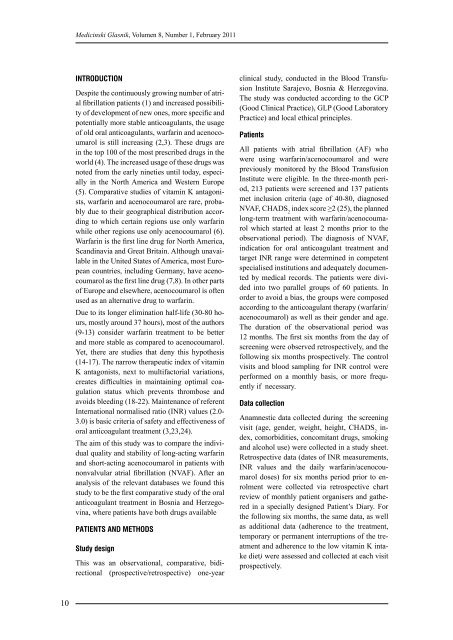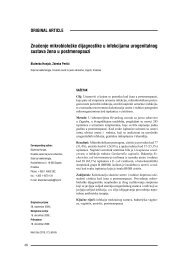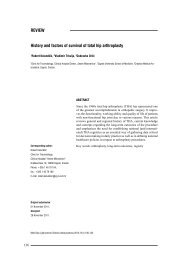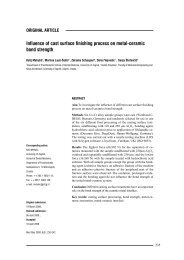MEDICINSKI GLASNIK - Aktuelno Ljekarska komora ZE - DO kantona
MEDICINSKI GLASNIK - Aktuelno Ljekarska komora ZE - DO kantona
MEDICINSKI GLASNIK - Aktuelno Ljekarska komora ZE - DO kantona
Create successful ePaper yourself
Turn your PDF publications into a flip-book with our unique Google optimized e-Paper software.
10<br />
Medicinski Glasnik, Volumen 8, Number 1, February 2011<br />
INTRODUCTION<br />
Despite the continuously growing number of atrial<br />
fibrillation patients (1) and increased possibility<br />
of development of new ones, more specific and<br />
potentially more stable anticoagulants, the usage<br />
of old oral anticoagulants, warfarin and acenocoumarol<br />
is still increasing (2,3). These drugs are<br />
in the top 100 of the most prescribed drugs in the<br />
world (4). The increased usage of these drugs was<br />
noted from the early nineties until today, especially<br />
in the North America and Western Europe<br />
(5). Comparative studies of vitamin K antagonists,<br />
warfarin and acenocoumarol are rare, probably<br />
due to their geographical distribution according<br />
to which certain regions use only warfarin<br />
while other regions use only acenocoumarol (6).<br />
Warfarin is the first line drug for North America,<br />
Scandinavia and Great Britain. Although unavailable<br />
in the United States of America, most European<br />
countries, including Germany, have acenocoumarol<br />
as the first line drug (7,8). In other parts<br />
of Europe and elsewhere, acenocoumarol is often<br />
used as an alternative drug to warfarin.<br />
Due to its longer elimination half-life (30-80 hours,<br />
mostly around 37 hours), most of the authors<br />
(9-13) consider warfarin treatment to be better<br />
and more stable as compared to acenocoumarol.<br />
Yet, there are studies that deny this hypothesis<br />
(14-17). The narrow therapeutic index of vitamin<br />
K antagonists, next to multifactorial variations,<br />
creates difficulties in maintaining optimal coagulation<br />
status which prevents thrombose and<br />
avoids bleeding (18-22). Maintenance of referent<br />
International normalised ratio (INR) values (2.0-<br />
3.0) is basic criteria of safety and effectiveness of<br />
oral anticoagulant treatment (3,23,24).<br />
The aim of this study was to compare the individual<br />
quality and stability of long-acting warfarin<br />
and short-acting acenocoumarol in patients with<br />
nonvalvular atrial fibrillation (NVAF). After an<br />
analysis of the relevant databases we found this<br />
study to be the first comparative study of the oral<br />
anticoagulant treatment in Bosnia and Herzegovina,<br />
where patients have both drugs available<br />
PATIENTS AND METHODS<br />
Study design<br />
This was an observational, comparative, bidirectional<br />
(prospective/retrospective) one-year<br />
clinical study, conducted in the Blood Transfusion<br />
Institute Sarajevo, Bosnia & Herzegovina.<br />
The study was conducted according to the GCP<br />
(Good Clinical Practice), GLP (Good Laboratory<br />
Practice) and local ethical principles.<br />
Patients<br />
All patients with atrial fibrillation (AF) who<br />
were using warfarin/acenocoumarol and were<br />
previously monitored by the Blood Transfusion<br />
Institute were eligible. In the three-month period,<br />
213 patients were screened and 137 patients<br />
met inclusion criteria (age of 40-80, diagnosed<br />
NVAF, CHADS 2 index score ≥2 (25), the planned<br />
long-term treatment with warfarin/acenocoumarol<br />
which started at least 2 months prior to the<br />
observational period). The diagnosis of NVAF,<br />
indication for oral anticoagulant treatment and<br />
target INR range were determined in competent<br />
specialised institutions and adequately documented<br />
by medical records. The patients were divided<br />
into two parallel groups of 60 patients. In<br />
order to avoid a bias, the groups were composed<br />
according to the anticoagulant therapy (warfarin/<br />
acenocoumarol) as well as their gender and age.<br />
The duration of the observational period was<br />
12 months. The first six months from the day of<br />
screening were observed retrospectively, and the<br />
following six months prospectively. The control<br />
visits and blood sampling for INR control were<br />
performed on a monthly basis, or more frequently<br />
if necessary.<br />
Data collection<br />
Anamnestic data collected during the screening<br />
visit (age, gender, weight, height, CHADS 2 index,<br />
comorbidities, concomitant drugs, smoking<br />
and alcohol use) were collected in a study sheet.<br />
Retrospective data (dates of INR measurements,<br />
INR values and the daily warfarin/acenocoumarol<br />
doses) for six months period prior to enrolment<br />
were collected via retrospective chart<br />
review of monthly patient organisers and gathered<br />
in a specially designed Patient’s Diary. For<br />
the following six months, the same data, as well<br />
as additional data (adherence to the treatment,<br />
temporary or permanent interruptions of the treatment<br />
and adherence to the low vitamin K intake<br />
diet) were assessed and collected at each visit<br />
prospectively.












